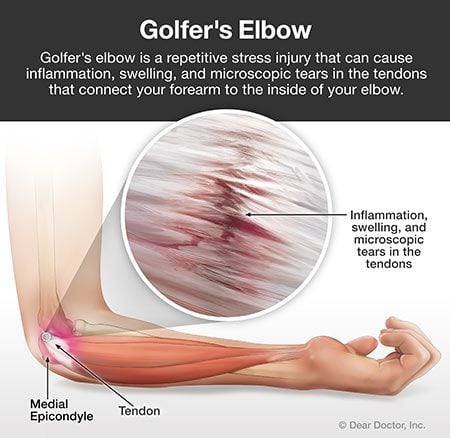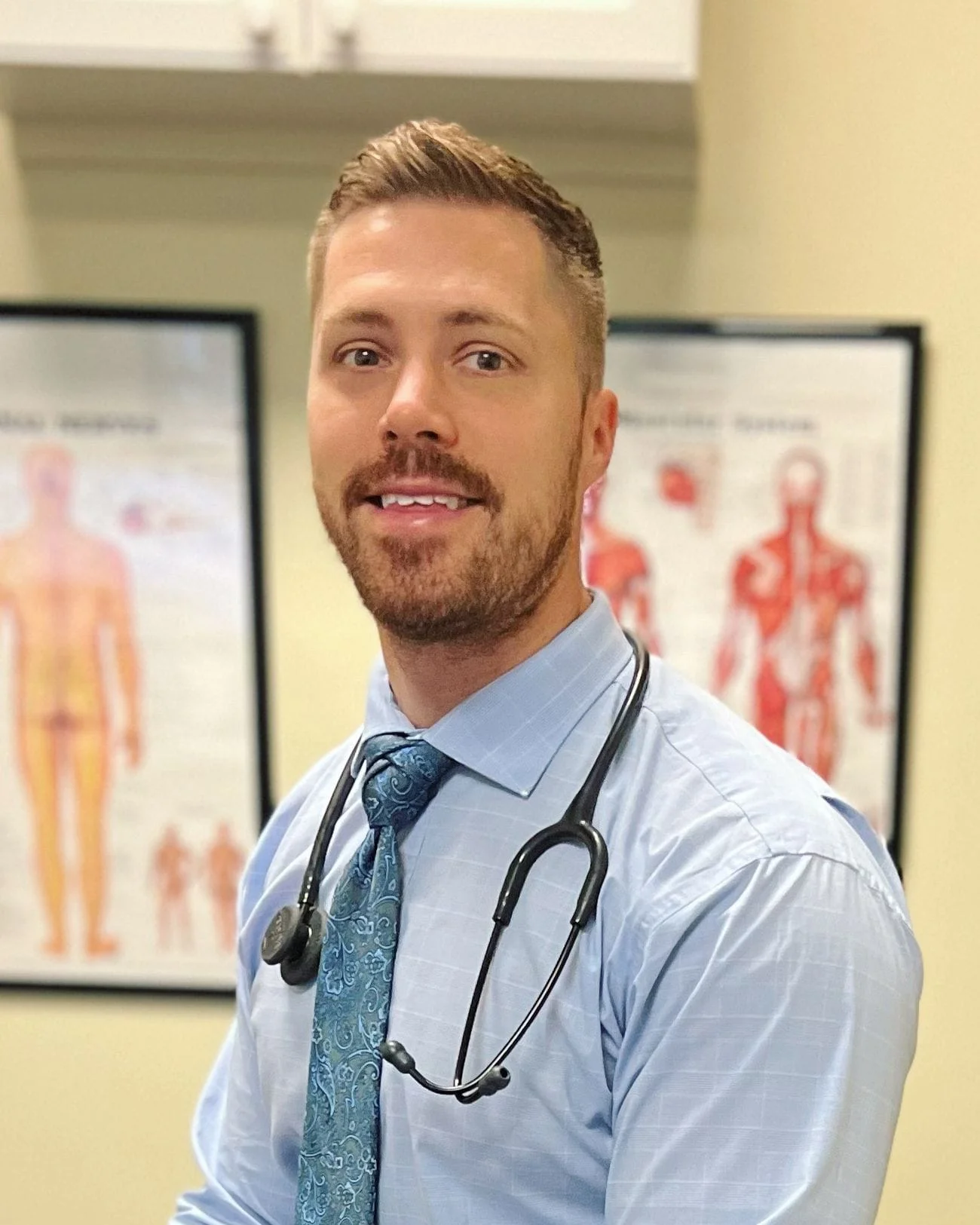What is Golfers Elbow?
Golfer’s elbow, or medial epicondylitis, is an overuse injury that can come about whether a person is a golfer or not. This condition causes pain in the elbow joint where the forearm connects to the elbow. Other symptoms associated with golfer’s elbow include stiffness, numbness, tingling, aching, a dull burn, and weakness. Pain can increase when the wrist is moved in a forceful repetitive motion, and it may travel up the arm. This can limit the elbow’s range of motion and may make straightening the arm painful and difficult.
This condition, as well as tennis elbow, are form of elbow tendonitis. The biggest difference between the two is that a golfer’s elbow affects the tendons on the inside of the elbow while a tennis elbow affects those on the outside of the elbow. While elbow tendonitis can negatively affect a person’s daily life, the good news is that chiropractic care can help alleviate the symptoms.
Causes of Golfer’s Elbow
Symptoms of a golfer’s elbow tend to show up when a person repetitively uses his/her hands and fingers in a way that strains or overworks the forearm muscles (especially those connected to the elbow). This is usually from gripping, flexing, or swinging repetitively for months to years. As a result of the strain, pulls or tiny tears can occur in the tendons, and scar tissue begins to form. The development of scar tissue in the elbow causes pain where the forearm tendons connect to the elbow bone.
Activities commonly known to cause this condition include golfing, baseball, rock climbing, texting, typing, playing video games, archery, using a hammer, playing football, and javelin throwing. If left untreated, golfer’s elbow can develop into a chronic condition that will likely require more intensive, expensive, and time-consuming health care.
Definition of Golfer's Elbow
Golfer's elbow, or medial epicondylitis, is a condition that involves pain and inflammation on the inside of the elbow where the forearm muscles and tendons attach to the bony bump on the inside of your elbow. This condition is often associated with repetitive activities and overuse of the forearm muscles.
Symptoms of Golfer's Elbow
The symptoms of golfer's elbow include pain and tenderness on the inside of the elbow, stiffness in the elbow joint, weakness in the hands and wrists, and difficulty in gripping objects. These symptoms can worsen with certain movements, such as bending the wrist or lifting objects.
Causes of Golfer's Elbow
Golfer's elbow is caused by overuse and repetitive stress on the muscles and tendons in the forearm. Activities such as golfing, throwing, and swinging a racket in tennis can contribute to the development of this condition. The repetitive motion puts strain on the tendons and can cause micro-tears in the soft tissue, leading to inflammation and pain.
How is Golfer's Elbow Treated?
Chiropractic Care for Golfer's Elbow
Chiropractic care can help alleviate the symptoms of golfer's elbow and promote healing. Chiropractors use various techniques such as soft tissue manipulation, chiropractic adjustments, and rehabilitation exercises to reduce pain, improve range of motion, and strengthen the forearm muscles.
Exercises for Golfer's Elbow
Specific exercises targeting the forearm muscles and tendons can aid in the recovery from golfer's elbow. These exercises focus on strengthening and stretching the affected area to promote healing and prevent future injuries. Range of motion exercises can also improve flexibility and reduce stiffness in the elbow joint.
Graston Technique for Golfer's Elbow
The Graston Technique, a form of manual therapy, can be beneficial for individuals with golfer's elbow. This technique involves using specialized tools to massage and manipulate the soft tissue, breaking down scar tissue and promoting healing in the affected area.
What Causes Golfer's Elbow?
Overuse and Golfer's Elbow
Overuse of the forearm muscles and repetitive movements are common causes of golfer's elbow. Engaging in activities that require constant gripping, twisting, or swinging motions can strain the tendons and lead to the development of this condition.
Tendon Injuries in Golfer's Elbow
Golfer's elbow is characterized by tendon injuries, particularly to the flexor tendons that attach to the medial epicondyle of the elbow. These injuries can result from repetitive stress, causing inflammation and pain in the affected area.
Activities and Golfer's Elbow
Certain activities such as golfing, racket sports, and manual labor tasks that involve repetitive wrist and arm movements can contribute to the onset of golfer's elbow. It's important to be mindful of proper technique and take breaks to prevent overuse injuries.
Chiropractic Treatment for Golfer's Elbow
Chiropractic Adjustments for Golfer's Elbow
Chiropractors can perform targeted adjustments to the elbow joint and surrounding areas to improve alignment and reduce pain associated with golfer's elbow. These adjustments can help restore proper function and mobility in the affected arm.
Benefits of Chiropractic Care for Golfer's Elbow
Chiropractic care can provide numerous benefits for individuals dealing with golfer's elbow, including pain relief, improved range of motion, and accelerated healing of soft tissue injuries. Chiropractors can also offer guidance on ergonomic modifications and preventive measures to avoid reoccurrence of the condition.
Scheduling an Appointment with a Chiropractor
If you are experiencing symptoms of golfer's elbow, it's important to schedule an appointment with a chiropractor for a comprehensive evaluation. A chiropractor can create a customized treatment plan to address your specific needs and support your recovery from this condition.
Golfer's Elbow Prevention
Preventing Golfer's Elbow with Proper Technique
Adopting proper technique and body mechanics during activities that involve repetitive arm movements can help prevent golfer's elbow. This includes using appropriate grip and posture while performing tasks and engaging in regular stretching exercises.
Strengthening Exercises for Golfers
Engaging in strengthening exercises that target the forearm muscles and improve grip strength can reduce the risk of developing golfer's elbow. Building endurance in the forearm muscles can provide added support and stability during activities that involve repetitive wrist and arm movements.
Range of Motion Exercises for Golfers
Incorporating range of motion exercises into your fitness routine can enhance flexibility in the elbow joint and surrounding musculature. This can help reduce stiffness and improve overall mobility, reducing the likelihood of overuse injuries such as golfer's elbow.
Treatment for Golfer’s Elbow
Chiropractic care typically uses a variety of approaches when treating the symptoms of golfer’s elbow. These techniques are designed to break up the scar tissue surrounding the elbow, reduce any inflammation in the elbow, and return the normal range of function to the elbow joint and forearm muscles. Treatment methods include spinal manipulation, myofascial release and active release techniques, massage, fascial stripping, stretching exercises for the forearm flexors and pectoral muscles, eccentric exercise therapy (challenging a muscle by slowing down the elongation of the muscle, such as when lowering a heavy object slowly), and Kinesio tape.
Why Seek Chiropractic Treatment for Golfer’s Elbow?
Since this condition can become chronic if left untreated, it’s important to correct any issues in the elbow as soon as the symptoms arise. If elbow tendonitis is suspected, we will examine your elbow, wrist, and cervical spine in an effort to eliminate added stressors that may be contributing to the pain. Upon pinpointing the cause of your pain, we can recommend a treatment plan based on your unique set of symptoms and daily activities. Keep in mind that chronic conditions left untreated for years may require more time and attention. The sooner you seek treatment for golfer’s elbow, the better your chances are of regaining a full range of motion and avoiding long-term difficulties with moving your arm.
More Conditions Treated
- Common Chiropractic Conditions
- Tennis Elbow
- Thoracic Outlet Syndrome
- TMJ
- Wrist Pain
- Scoliosis
- Spinal Stenosis
- Strains & Sprains
- Tech Neck/ Text Neck
- Tendonitis
- Pinched Nerve
- Sciatica
- Neck Pain
- Neuropathy
- Osteoarthritis
- Pregnancy Pain
- Joint Pain
- Mid/Upper Back Pain
- Posture Problems
- Golf Elbow
- Introduction to Common Conditions
- Plantar Fasciitis
- Forward Head Posture
- Lower Back Pain
- Pitcher's Elbow
- Fibromyalgia
- Hip Pain
- Knee Pain
- Carpal Tunnel Syndrome
- Dizziness & Vertigo
- Headache & Migraine
- Ear & Sinus Pain
- Degenerative Disc Disease
- Back Pain
- Bulging & Herniated Disc


